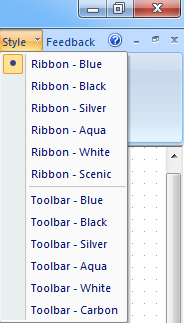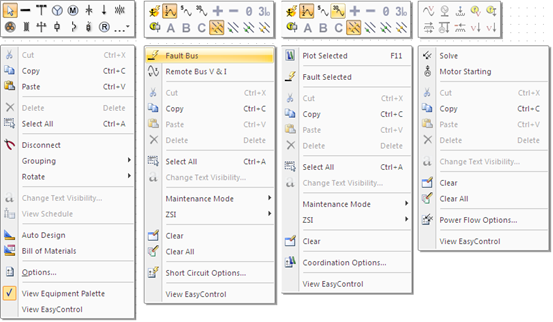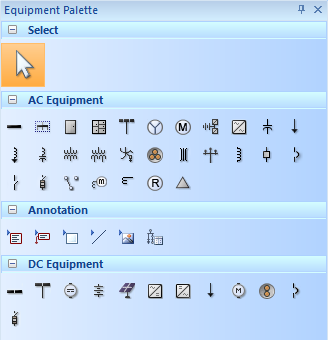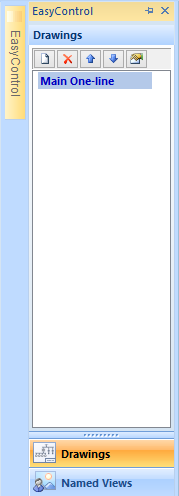 Maximize button on the upper-right of the EasyPower window to make the session window fill the screen. Click
Maximize button on the upper-right of the EasyPower window to make the session window fill the screen. Click
 Maximize in the one-line window to fill the session window with the one-line.
Maximize in the one-line window to fill the session window with the one-line.After you start EasyPower, the session window opens. Click the  Maximize button on the upper-right of the EasyPower window to make the session window fill the screen. Click
Maximize button on the upper-right of the EasyPower window to make the session window fill the screen. Click
 Maximize in the one-line window to fill the session window with the one-line.
Maximize in the one-line window to fill the session window with the one-line.

Figure 1: EasyPower Session
The session window elements are described in the topics that follow.
Ribbons let you tell EasyPower what you want to do next. Ribbon buttons that are unavailable at a given time are dimmed. Some buttons have a down-arrow symbol  indicating additional options are available. Your ribbon may look different from the one below, depending on the product features your company purchased.
indicating additional options are available. Your ribbon may look different from the one below, depending on the product features your company purchased.

Figure 2: EasyPower Ribbon
Ribbons were introduced in EasyPower 9.0 and provide a more efficient way to work with EasyPower. Previous versions supported a menu bar and toolbars.
You can change the appearance of the ribbon by choosing Style from the upper right area of the window.

Figure 3: Change Style
For the purposes of this documentation, only the ribbon options are described in detail, but the toolbar and menu options are similar in most cases.

Figure 4: Quick Access Toolbar
The Quick Access Toolbar is located at the top left area of the EasyPower window when the style is set to ribbons. By default this toolbar has the commands New (create a new one-line), Open, Save, Print and Undo.
Click  Customize Quick Start Toolbar to add or remove items from the toolbar.
Customize Quick Start Toolbar to add or remove items from the toolbar.
You can click right-click anywhere on the screen to display an additional context-sensitive menu. The menu changes based on where you are working in the software. Only options that are appropriate for that area are displayed. Some options may be appropriate for the area but are dimmed until a specific action is taken (for example, only after selecting an item onscreen).

Figure 5: Context Menu Examples
There is an optional Status bar at the bottom of the session window that provides information about settings you have chosen. The information displayed varies slightly depending on the current focus you are in.

Figure 6: Status Bar
You can right-click on the status bar to select different information to display.
The Equipment Palette enables you to add AC or DC equipment and notes ("Annotations") to the one-line. While you are editing the database, the equipment palette provides the necessary equipment types to create a power system one-line diagram.
Tip: You can also insert items through the Insert ribbon.

Figure 7: The Equipment Palette
Tip: You can right-click on the palette and switch between a List View or an Icon View. You can also hover over the icons while in Icon View to see a description of the equipment symbol.
You can hide or show the equipment palette by right-clicking in the one-line area and selecting the desired option from the context menu.
For more information about what each symbol represents, see Equipment Palette Symbols.
The EasyControl toolbox provides easy access to your drawings and named views. By default, it appears as a tab next to the Equipment Palette. When you hover over the EasyControl tab, the toolbox appears.

Figure 8: EasyControl Toolbox
For more information, see Drawings and Named Views.
You can hide or show the EasyControl tab by right-clicking in the one-line area and selecting the desired option from the context menu.
| Your First EasyPower One‑line | |
| EasyPower Focus |

|